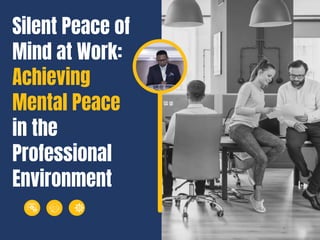Silent Peace of Mind at Work Achieving Mental Peace in the Professional Environment.pptx
In today's frenetic scenario, the search for silent tranquility in the workplace becomes an essential journey towards mental and emotional balance. This concept goes beyond the simple absence of external noise; it's about cultivating a state of internal serenity, even amid the challenging demands of the corporate world. Achieving peace of mind in a professional environment is a feat that requires awareness and deliberate practice. It involves the ability to manage stress, find focus and maintain an inner calm that allows you to deal with adverse situations in a calm and considered way. When entering this universe of tranquility at work, we come across valuable strategies, such as the practice of mindfulness. This technique, based on mindfulness of the present moment, offers a powerful tool for reducing anxiety, bringing mental clarity and promoting a more peaceful internal environment. The definition of limits and priorities proves to be a fundamental anchor in this search for serenity in the professional context. Knowing how to say "no" when necessary, establish realistic priorities and delegate tasks is crucial to avoid overload and allow a healthy balance between work responsibilities and personal life. Efficient time management and organization become powerful allies on this journey. Setting clear goals, avoiding procrastination and integrating regular breaks throughout the day not only provide a feeling of control over activities, but also moments of rest that invigorate the mind and make it more capable of facing everyday challenges. The benefits of seeking this quiet tranquility in the workplace are vast. A calm and balanced mind not only promotes greater creativity and productivity, but also favors more assertive decision-making and contributes to healthier and more collaborative interpersonal relationships. In short, achieving peace of mind in a professional context does not mean running away from responsibilities or challenges, but rather embracing a conscious and balanced approach to facing them. It is a journey that values self-care, emotional management and the search for inner peace as fundamental pillars for a healthy and productive work environment for everyone involved.

Recommended
Recommended
More Related Content
Similar to Silent Peace of Mind at Work Achieving Mental Peace in the Professional Environment.pptx
Similar to Silent Peace of Mind at Work Achieving Mental Peace in the Professional Environment.pptx (20)
Silent Peace of Mind at Work Achieving Mental Peace in the Professional Environment.pptx
- 1. Silent Peace of Mind at Work: Achieving Mental Peace in the Professional Environment
- 2. In the busy world we live in, finding tranquility in the workplace is essential to maintaining mental health and well-being. The Roman philosopher Seneca highlighted restlessness as a symptom of a sick mind, emphasizing the importance of seeking inner serenity to achieve a fulfilling life. How can we apply this Seneca perspective to our contemporary professional lives?
- 3. THE NATURE OF RESTLESSNESS AT WORK Unrest in the workplace is often the result of various pressures and demands. The constant need to meet deadlines, competitiveness, information overload and rising expectations can lead to a state of mental agitation. This not only harms productivity, but also affects the mental and emotional health of workers.
- 4. Whoever opens his heart to ambition closes it to tranquility. Chinese Proverb The innocent walks with tranquility. Jewish Texts The Search for Quiet Tranquility
- 5. Seeking quiet tranquility at work does not mean eliminating challenges or avoiding responsibilities, but rather adopting a more balanced and conscious approach to professional demands. Here are some strategies that can help in this search: • Mindfulness Practice • Establishing Limits and Priorities • Organization and Time Management • Interval and Rest Practice
- 6. 1. Practice Mindfulness The practice of full attention or mindfulness has been shown to be effective in reducing stress and promoting mental tranquility. Taking a few minutes during the day to focus on your breathing, observe your thoughts without judgment, and be present in the current moment can bring clarity and calm to the mind.
- 7. 12. Establishing Limits and Priorities Setting clear limits and realistic priorities is key to avoiding work overload. Learning to say "no" when necessary and delegating tasks when possible allows for a healthy work-life balance.
- 8. 3. Organization and Time Management A well-structured schedule and efficient time management are essential to reduce feelings of overload. Setting daily goals, prioritizing tasks and avoiding procrastination can significantly contribute to a calmer and more productive work environment.
- 9. 4. Practice Intervals and Rest Integrating regular breaks throughout the workday is crucial. Moments of rest, whether walking, meditating for a few minutes or simply disconnecting for a brief period, allow you to recharge your energy and keep your mind more focused and calm.
- 10. Benefits of Peace of Mind at Work Seeking tranquility in the professional environment not only improves mental health, but also brings tangible benefits to work performance. A more serene state of mind promotes: Criativity Greater Creativity and Productivity: A calm mind is more likely to generate innovative ideas and maintain a sharper focus on tasks. Decision The mental clarity resulting from tranquility allows you to make more considered and assertive decisions. Healthy Relationships Serenity promotes a more collaborative and positive work environment, improving communication and relationships between colleagues.
- 11. Conclusion 123-456-7890 In short, finding quiet tranquility in the workplace is more than a personal aspiration; it is a necessity for mental health and professional success. Following Seneca's teachings and prioritizing the pursuit of a peaceful mind not only benefits the individual, but also contributes to a healthier and more productive work environment for everyone. Therefore, let us seek this tranquility, not as an escape from professional demands, but as a way to strengthen ourselves and bring a more balanced and serene approach to our daily activities.